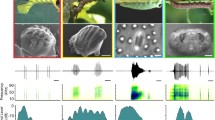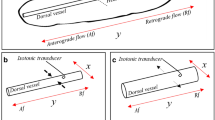Abstract
Bristle patches on the carapace behind the eyes were found for the first time in both males and females of the four species of mud crab Scylla spp. Electrocardiography revealed that the bristle patches of Scylla paramamosain were sensitive to touch (with a glass capillary) but not to chemical stimulation (with sugarcane juice). To elucidate the function of these touch signals, the courtship behaviour of S. paramamosain was video-recorded in a broodstock tank. A male approached a female, extended a walking leg over her carapace, touched her bristle patches with a dactyl, mounted her, and probed the bristle patches further with the third maxillipeds. Touch stimulus may be a signal for courtship in Scylla and one of the chain stimuli for the completion of mating behaviour.



Similar content being viewed by others
References
Baldwin J, Johnsen S (2012) The male blue crab, Callinectes sapidus, uses both chromatic and achromatic cues during mate choice. J Exp Biol 215:1184–1191
Breithaupt T, Hardege JD (2012) Pheromones mediating sex and dominance in aquatic animals. In: Brönmark C, Hansson LA (eds) Chemical ecology in aquatic systems. Oxford University Press, Oxford, pp 39–56
Crane J (1975) Fiddler crabs of the world. Ocypodidae: genus Uca. Princeton University Press, Princeton
Derby CD (1982) Structure and function of cuticular sensilla of the lobster Homarus americanus. J Crustac Biol 2:1–21
Detto T (2007) The fiddler crab Uca mjoebergi uses colour vision in mate choice. Proc R Soc B 274:2785–2790
Donaldson WE, Adams AE (1986) An ethogram and description of mating behavior for the tanner crab, Chionoecetes bairdi MJ Rathbun. Information leaflet no. 256. Department of Fish and Game, AK
Fazhan H, Waiho K, Wan Norfaizza WI, Megat FH, Ikhwanuddin M (2017) Inter-species mating among mud crab genus Scylla in captivity. Aquaculture 471:49–54
Fazhan H, Waiho K, Quinitio E, Baylon JC, Fujaya Y, Rukminasari N, Azri MFD, Shahreza MS, Ma H, Ikwanudin M (2020) Morphological descriptions and morphometric discriminant function analysis reveal an additional four groups of Scylla spp. PeerJ 8:e8066. https://doi.org/10.7717/peerj.8066
Guilford T, Dawkins MS (1991) Receiver psychology and the evolution of animal signals. Anim Behav 42:1–14
Herborg LM, Bentley MG, Clare AS, Last KS (2006) Mating behaviour and chemical communication in the invasive Chinese mitten crab Eriocheir sinensis. J Exp Mar Biol Ecol 329:1–10
Horch KW, Salmon M (1969) Production, perception and reception of acoustic stimuli by semiterrestrial crabs (genus Ocypode and Uca, family Ocypodidae). Forma Funct 1:1–25
Islam ML, Yahya KB (2017) Variations in age and size at sexual maturity of female green mud crab (Scylla paramamosain) under different captive growout conditions. Int J Fish Aquac Stud 5:451–457
Kamio M, Araki M, Nagayama T, Matsunaga S, Fusetani N (2005) Behavioral and electrophysiological experiments suggest that the antennular outer flagellum is the site of pheromone reception in the male helmet crab Telmessus cheiragonus. Biol Bull 208:12–19
Kamio M, Reidenbach MA, Dervy D (2008) To paddle or not: context dependent courtship display by male blue crabs, Callinectes sapidus. J Exp Biol 211:1249–1248
Lenz PH, Hartline DK (2014) Mechanoreception in crustaceans of the pelagic realm. In: Derby C, Thiel M (eds) Neurosystems and control of behavior. Oxford University Press, Oxford, pp 293–320
Lerosey-Aubril R, Meyer R (2013) The sensory dorsal organs of crustaceans. Biol Rev 88:406–426
Liew KS, Yong ASK, Lim L-S, Kawamura G (2020) Dietary sugarcane juice as a feeding stimulant for the purple mud crab Scylla tranquebarica. Aquac Res 51:2164–2167
Murai M, Backwell PY (2005) More signaling for earlier mating: conspicuous male claw waving in the fiddler crab, Uca perplexa. Anim Behav 70:1093–1097
Nishi T, Kawamura G, Matsumoto K (2004) Magnetic sense in the Japanese eel, Anguilla japonica, as determined by conditioning and electrocardiography. J Exp Biol 207:2965–2970
O’Rourke CF, Mendelson TC (2010) Male and female preference for conspecifics in a fish with male parental care (Percidae: Cotonotus). Behav Process 85:157–162
Robertson JR, Fudge JA, Vermeer GK (1981) Chemical and live feeding stimulants of the sand fiddler crab, Uca pugilator (Bose). J Exp Mar Biol Ecol 53:47–64
Salmon M, Atsaides SP (1969) Sensitivity to substrate vibration in the fiddler crab, Uca pugilator Bosc. Anim Behav 17:68–76
Schmidt M, Jr Mellon D (2011) Neural processing of chemical information in crustaceans. In: Breithaupt T, Thiel M (eds) Chemical communication in crustaceans. Springer, New York, pp 123–147
Schöne H (1968) Agonistic and sexual display in aquatic and semi-terrestrial brachyuran crabs. Am Zool 8:641–654
Shelley C, Lovatelli A (2011) Mud crab culture—a practical manual. FAO Fisheries and Aquaculture technical paper no. 567. FAO, Rome
Snell TW (2011) Contact chemoreception and its role in zooplankton mate recognition. In: Breithaupt T, Thiel M (eds) Chemical communication in crustaceans. Springer, New York, pp 451–466
Soundarapandian P, Varadharajan D, Ilavarasan N, Kumar J, Kumar A (2013) Mating behaviour of flower crab, Charybdis feriata (Linnaeus). J Mar Sci Res Dev 3:127. https://doi.org/10.4172/2155-9910.1000127
Waiho K, Mustaqim M, Fazahn H, Norfaizza WIW, Megat FH, Ikhwanuddin M (2015) Mating behaviour of the orange mud crab, Scylla olivacea: the effect of sex ratio and stocking density on mating success. Aquac Rep 2:50–57
Wine JJ, Krasne FB (1982) The cellular organization of crayfish escape behavior. In: Sandeman DC, Atwood HL (eds) The biology of Crustacea, vol 4. Neural integration and behavior. Academic Press, New York, pp 242–292
Acknowledgements
We thank Miss Fui Yin Thien for species identification of the mud crabs. This study was partially funded by Universiti Malaysia Sabah grant SDK0028-2018.
Author information
Authors and Affiliations
Corresponding author
Ethics declarations
Conflict of interest
The authors declare that they have no conflict of interest.
Ethical approval
This article does not describe any studies with human participants or animals performed by any of the authors. All applicable international, national, and/or institutional guidelines for the care and use of animals were followed.
Additional information
Publisher's Note
Springer Nature remains neutral with regard to jurisdictional claims in published maps and institutional affiliations.
Rights and permissions
About this article
Cite this article
Kawamura, G., Bagarinao, T.U., Loke, C.K. et al. Touch-sensitive bristles on the carapace of the mud crab Scylla paramamosain may be receptors for courtship signals. Fish Sci 87, 65–70 (2021). https://doi.org/10.1007/s12562-020-01478-2
Received:
Accepted:
Published:
Issue Date:
DOI: https://doi.org/10.1007/s12562-020-01478-2




